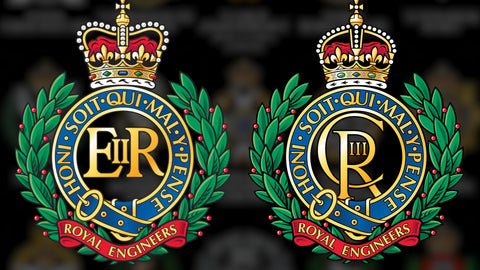**NEW** British Army Cap Badges Revealed - Tudor Crown / Kings Crown / C3R Cypher
Forty-six of the British Army’s Corps and Regimental cap badges showing His Majesty The King's cypher have been unveiled.
Worn for the first time by military personnel taking part in the Coronation, they will become the official new symbol for the Regiments and Corps. The design of the badges reflect the cypher and the Tudor Crown, which appears in The King's cypher.
They include such famous names as The Queen’s Royal Hussars, The Parachute Regiment, the Gurkhas and the Grenadier Guards.
below is a comparison of the cypher / crown change

All logos have been designed by the College of Arms.
But who are they?
The College of Arms is an official institution in the United Kingdom that is responsible for maintaining and regulating the use of coats of arms and other heraldic devices. It is also responsible for granting new coats of arms and overseeing the registration of genealogies and pedigrees.
The College of Arms was originally established in 1484 by King Richard III, although the office of the Kings of Arms dates back to the early Middle Ages. The institution is made up of three separate offices: the Kings of Arms, who are responsible for granting new coats of arms and overseeing the work of the other officers; the Heralds, who assist the Kings of Arms in their duties and also have their own heraldic functions; and the Pursuivants, who are junior officers tasked with supporting the work of the Kings of Arms and Heralds.
The College of Arms has played an important role in the history of the United Kingdom, particularly in the realm of heraldry and genealogy. Over the centuries, it has granted coats of arms to thousands of individuals and families, and has been responsible for overseeing the use of heraldry in various public and ceremonial settings.
In addition to its official duties, the College of Arms is also a repository of historical documents and artifacts, including medieval manuscripts, armorials, and other heraldic materials. Its library and archives are open to the public for research purposes, and it also hosts a number of exhibitions and events throughout the year.
Some notable moments in the history of the College of Arms include:
- In 1485, just one year after its establishment, the College of Arms played a key role in the Battle of Bosworth, where King Richard III was killed and replaced by Henry Tudor. The heralds of the College supported Henry Tudor's claim to the throne by carrying his coat of arms into battle and announcing his victory.
- During the English Civil War in the 17th century, the College of Arms continued to operate under the authority of the monarch, despite the fact that the country was divided between Royalist and Parliamentary forces. This was a testament to the institution's longevity and enduring importance in the realm of heraldry and genealogy.
- In the 20th century, the College of Arms has continued to play a prominent role in British public life, overseeing the design and use of coats of arms for a variety of individuals and institutions, including the Royal Family, the armed forces, and numerous local and regional authorities.
Overall, the College of Arms is an important institution in the history and culture of the United Kingdom, and its work continues to have an impact on the country's public life and heritage.
